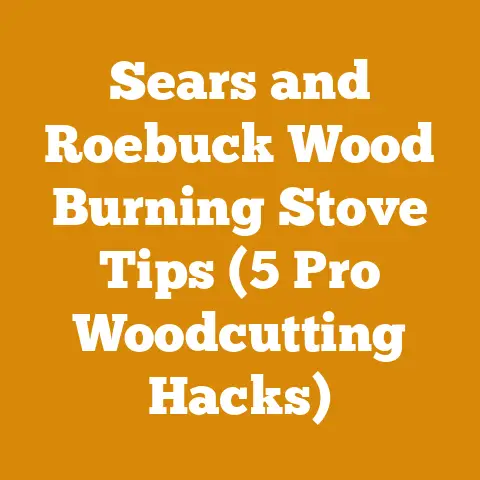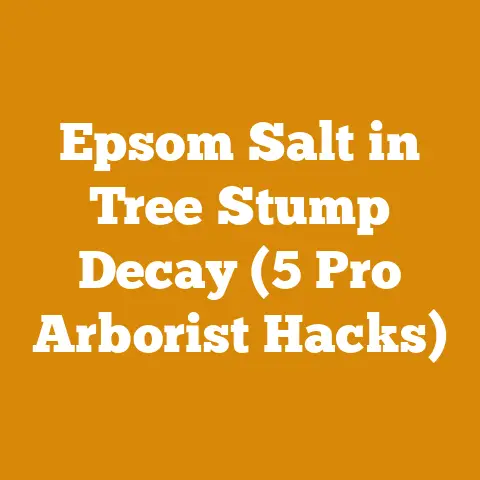What Wood Burns the Hottest and Longest (BTU Heat Chart Revealed)
Introduction
The crisp autumn air, the satisfying thud of a splitting maul, and the promise of a warm fire – these are the things that draw me, and likely you, to the world of firewood. But beyond the romance lies a practical question: what wood truly burns the hottest and longest? This isn’t just about a cozy evening; it’s about efficiency, sustainability, and getting the most bang for your buck, or rather, the most heat for your wood.
In recent years, I’ve noticed a surge in interest in efficient wood burning. Maybe it’s the rising cost of propane, a renewed interest in self-sufficiency, or simply a desire to connect with a more primal form of energy. Whatever the reason, people are getting serious about their firewood. They’re asking the tough questions: which species pack the most heat? How does moisture content affect burn time? And what are the best practices for storing and seasoning wood for optimal performance?
This isn’t just about chucking any old log into the fireplace. We’re talking about optimizing your wood-burning experience. So, let’s dive deep into the science of firewood, explore the BTU heat chart, and uncover the secrets to maximizing heat output and burn time.
Key Takeaways:
- BTU is King: Understand what British Thermal Units (BTUs) are and why they are the gold standard for measuring firewood heat output.
- Hardwoods Reign Supreme: Discover why dense hardwoods like oak, hickory, and beech are the top contenders for hottest and longest burns.
- Moisture is the Enemy: Learn how proper seasoning drastically impacts BTU output and reduces creosote buildup.
- Species Matters: Explore a detailed BTU chart and breakdown of various wood species, from common to more exotic options.
- Beyond the BTU: Consider factors beyond heat output, such as ease of splitting, smoke production, and availability.
- Optimize Your Burn: Implement best practices for wood storage, stove maintenance, and burning techniques to maximize efficiency.
The Science of Firewood: Understanding BTUs
Before we get into specific wood types, let’s talk about the fundamental unit of measurement: the BTU, or British Thermal Unit. A BTU is the amount of energy required to raise the temperature of one pound of water by one degree Fahrenheit. In the context of firewood, it tells us how much heat a particular type of wood will produce when burned. The higher the BTU rating, the more heat you’ll get.
Think of it this way: a BTU is like a calorie for your fireplace. Just as some foods are more calorie-dense than others, some woods are more BTU-dense. This density comes from the amount of lignin and other combustible compounds packed into the wood.
Why BTU Matters
Understanding BTU ratings is crucial for several reasons:
- Efficiency: Choosing high-BTU wood means you’ll need less wood to heat your home, saving you time, money, and effort.
- Cost-Effectiveness: While high-BTU wood might be slightly more expensive upfront, the increased heat output often makes it a better value in the long run.
- Stove Performance: Knowing the BTU rating of your wood helps you optimize your wood stove or fireplace for efficient and safe operation.
- Environmental Impact: Burning less wood to achieve the same level of heat reduces emissions and minimizes your environmental footprint.
The Contenders: Hardwoods vs. Softwoods
The first rule of thumb is that hardwoods generally burn hotter and longer than softwoods. This is because hardwoods are denser, meaning they contain more combustible material per cubic foot.
- Hardwoods: These come from deciduous trees that lose their leaves annually. Examples include oak, maple, hickory, ash, and beech. They are typically slower-growing, resulting in denser wood.
- Softwoods: These come from coniferous trees that retain their needles year-round. Examples include pine, fir, spruce, and cedar. They are typically faster-growing and less dense.
Personal Anecdote:
I remember one particularly harsh winter where I tried to get by solely on softwood. Big mistake! I was constantly feeding the stove, and the house never felt truly warm. That’s when I learned the hard way about the importance of hardwoods.
The BTU Heat Chart: A Detailed Breakdown
Now, let’s get to the heart of the matter: the BTU heat chart. This chart provides a comparative look at the heat output of various wood species, measured in millions of BTUs per cord (MMBTU/cord). Keep in mind that these are average values, and actual heat output can vary depending on factors like moisture content and wood quality.
| Wood Species | MMBTU/Cord (Approximate) | Density (lbs/ft3) | Notes |
|---|---|---|---|
| Osage Orange | 32.9 | 58 | Exceptionally hot burning, very dense and difficult to split. Produces very little smoke. |
| Ironwood (Hophornbeam) | 30.0 | 53 | Extremely dense and burns very hot. Can be difficult to ignite, but burns for a long time once established. |
| Hickory (Shagbark) | 27.7 | 48 | Excellent heat output, good coaling properties. |
| Beech | 27.0 | 46 | Similar to oak in heat output, burns cleanly. |
| Oak (Red) | 26.4 | 45 | A classic firewood choice, burns hot and long. Needs proper seasoning. |
| Oak (White) | 27.2 | 48 | Denser than red oak, slightly higher BTU. |
| Maple (Sugar) | 24.0 | 44 | Good heat output, burns cleanly. |
| Ash | 23.6 | 41 | Easy to split, burns well even when slightly green. |
| Cherry | 20.0 | 35 | Burns with a pleasant aroma, good for occasional use. |
| Birch (Yellow) | 20.2 | 41 | Good heat output, but burns relatively quickly. |
| Elm | 19.6 | 37 | Can be difficult to split, lower heat output than oak or hickory. |
| Pine (White) | 15.8 | 24 | Burns quickly, produces more smoke than hardwoods. Best for kindling or shoulder season use. |
| Fir (Douglas) | 16.9 | 30 | Similar to pine, burns quickly and produces more smoke. |
| Spruce | 13.7 | 24 | Lowest heat output, burns very quickly. |
| Cedar | 13.0 | 23 | Aromatic, but low heat output and burns quickly. Best for kindling or outdoor fires. |
| Cottonwood | 12.8 | 24 | Very low heat output, burns very quickly and produces a lot of smoke. Not recommended for primary heating. |
| Willow | 12.6 | 23 | Similar to cottonwood, low heat output and burns quickly. |
In-Depth Look at the Top Performers
Let’s delve deeper into the top contenders on the BTU chart:
- Osage Orange (32.9 MMBTU/cord): This wood is a powerhouse. It’s incredibly dense, burns extremely hot, and produces very little smoke. However, it’s notoriously difficult to split, and availability can be limited. I’ve only had the pleasure of burning Osage Orange a few times, and it’s truly an experience. The heat is intense, and the burn time is remarkable.
- Ironwood (Hophornbeam) (30.0 MMBTU/cord): As the name suggests, this wood is incredibly hard and dense. It burns very hot and for a long time. It can be difficult to ignite, but once it gets going, it’s a reliable source of heat.
- Hickory (27.7 MMBTU/cord): Hickory is a classic firewood choice for a reason. It offers excellent heat output and good coaling properties, meaning it burns down to hot coals that provide sustained heat. It’s also relatively easy to split compared to Osage Orange or Ironwood.
- Oak (Red and White) (26.4-27.2 MMBTU/cord): Oak is another popular and reliable choice. It burns hot and long, but it needs proper seasoning to reach its full potential. Red oak tends to dry faster than white oak.
- Beech (27.0 MMBTU/cord): Beech is often compared to oak in terms of heat output and burn quality. It burns cleanly and produces a steady, even heat.
The Importance of Seasoning: Drying Wood for Optimal Performance
No matter how high the BTU rating of your wood, it won’t perform well if it’s not properly seasoned. Seasoning is the process of drying wood to reduce its moisture content. Freshly cut (“green”) wood can contain as much as 50% moisture by weight. Ideally, firewood should be seasoned to a moisture content of 20% or less.
Why Seasoning Matters
- Increased Heat Output: Wet wood wastes energy evaporating water instead of producing heat. Seasoned wood burns hotter and more efficiently.
- Reduced Smoke and Creosote: Burning wet wood produces excessive smoke and creosote, a flammable substance that can build up in your chimney and cause a fire hazard.
- Easier Ignition: Dry wood is much easier to light than wet wood.
- Longer Burn Time: Seasoned wood burns more slowly and consistently.
Seasoning Best Practices
- Split the Wood: Splitting wood increases its surface area, allowing it to dry more quickly.
- Stack It Properly: Stack the wood in a single row, off the ground, with good air circulation.
- Choose a Sunny and Windy Location: Sunlight and wind help to evaporate moisture.
- Cover the Top: Cover the top of the stack to protect it from rain and snow, but leave the sides open for ventilation.
- Be Patient: Seasoning typically takes 6-12 months, depending on the wood species and climate.
Using a Moisture Meter
A moisture meter is an invaluable tool for determining whether your wood is properly seasoned. Simply insert the probes into a freshly split piece of wood and read the moisture content. Aim for 20% or less.
Beyond the BTU: Other Factors to Consider
While BTU rating is a crucial factor in choosing firewood, it’s not the only one. Here are some other considerations:
- Ease of Splitting: Some woods, like ash, are relatively easy to split, while others, like elm, can be a nightmare.
- Smoke Production: Some woods produce more smoke than others, which can be a concern for indoor burning.
- Sparking: Some woods, particularly softwoods like pine, tend to spark and throw embers, making them less suitable for open fireplaces.
- Availability: The best firewood in the world is useless if you can’t get your hands on it. Consider what species are readily available in your area.
- Cost: Firewood prices vary depending on the species, quality, and location. Factor in the cost per BTU when making your decision.
- Aroma: Some woods, like cherry and apple, produce a pleasant aroma when burned, adding to the ambiance of a fire.
Case Study: Comparing Oak and Pine
Let’s look at a practical example: comparing oak and pine. Oak has a significantly higher BTU rating than pine (around 26 MMBTU/cord vs. 16 MMBTU/cord). This means you’ll need significantly more pine to produce the same amount of heat as oak.
In addition, pine burns much faster than oak, requiring more frequent tending of the fire. Pine also produces more smoke and creosote, which can be a nuisance and a safety hazard.
While pine might be cheaper and easier to find in some areas, the long-term cost and effort often outweigh the initial savings. Oak, on the other hand, provides more heat, burns longer, and produces less smoke, making it a more efficient and cost-effective choice in the long run.
Tips and Tricks for Maximizing Heat Output
Here are some additional tips and tricks for maximizing the heat output of your firewood:
- Store Your Wood Properly: Keep your seasoned wood dry and protected from the elements.
- Maintain Your Stove or Fireplace: Clean your chimney regularly to prevent creosote buildup. Ensure that your stove or fireplace is properly sealed and operating efficiently.
- Use the Right Burning Techniques: Experiment with different burning techniques, such as top-down burning, to optimize airflow and combustion.
- Mix Wood Types: Consider mixing different wood types to achieve a balance of heat output, burn time, and ease of ignition. For example, you might use birch or pine to get the fire started and then switch to oak or hickory for sustained heat.
- Consider a Wood Stove Fan: A wood stove fan can help circulate warm air throughout your home, improving heating efficiency.
The Future of Firewood: Sustainable Practices
As we become more conscious of our environmental impact, it’s essential to consider sustainable practices when sourcing and using firewood.
- Source Locally: Buy firewood from local suppliers to reduce transportation emissions.
- Harvest Responsibly: If you harvest your own firewood, follow sustainable forestry practices to ensure the long-term health of the forest.
- Burn Efficiently: Use a modern, EPA-certified wood stove or fireplace to minimize emissions.
- Consider Alternative Fuels: Explore alternative fuels, such as wood pellets or biobricks, which can be more efficient and environmentally friendly than traditional firewood.
Addressing Common Concerns
- “My wood is seasoned, but it still smokes a lot.” This could be due to several factors, including poor airflow in your stove or fireplace, burning wood that is still slightly damp, or burning wood that is naturally smoky, such as certain types of pine.
- “I can’t find high-BTU wood in my area.” Focus on finding the densest hardwoods available to you. Even lower-BTU hardwoods will outperform softwoods.
- “Is it safe to burn treated wood?” Never burn treated wood, as it can release toxic chemicals into the air.
Conclusion: Embrace the Heat
Choosing the right firewood is a science and an art. By understanding the BTU heat chart, mastering the art of seasoning, and considering other factors like ease of splitting and smoke production, you can optimize your wood-burning experience and enjoy the warmth and comfort of a crackling fire all winter long.
Remember, the best firewood is the one that meets your specific needs and circumstances. Experiment with different wood types, learn from your experiences, and embrace the knowledge to make informed decisions. Happy burning!






